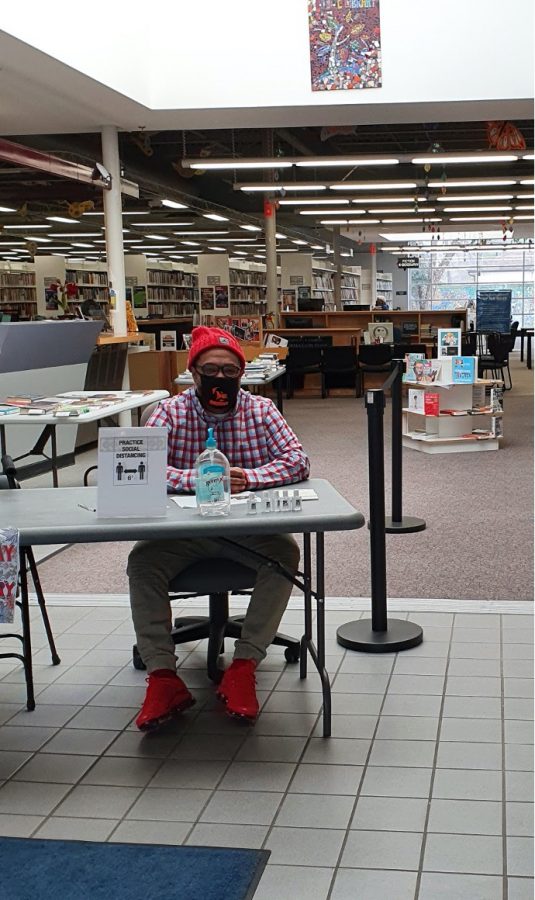College, Public Libraries Reimagine Sharing Knowledge
Courtesy of Oberlin Public Libraries
Oberlin Public Libraries have collaborated with several other community organizations to remain a space for connection and to continue offering services and resources during the pandemic.
Oberlin’s libraries have remained invaluable sources of knowledge and wellbeing for both Oberlin residents and students, sharing community and resources despite pandemic restrictions. Since the abrupt shutdowns last March, both College and public libraries have adapted and recovered much of their essential functioning by adopting socially distanced operations and creating virtual programming.
Though Oberlin Public Libraries physically closed down at the beginning of the pandemic, it continued to offer library resources by shifting operations online and creating digital library cards. The library’s website introduced a number of new platforms and databases from the Ohio Library Council, including TumblebookLibrary, an online library for kids. Currently, OPL is open again for in-person browsing hours in addition to curbside pickup.
Even though the pandemic sparked innovation and new programs, it also brought cuts. When OPL physically reopened two months after the onset of the pandemic, it nearly halved its normal staff.
“Part of that is budgetary, and part of it is also just the number of people we feel safe being regularly exposed to,” Adult Services Team Leader at OPL Rebecca Wedge wrote in an email to the Review. “Library buildings are designed to maximize floor space for the collection so socially distant workspaces that offer protection from both the public and coworkers are difficult to achieve.”
Similarly to the public library, the College libraries also had to reimagine their operations for the pandemic. In-person occupancy has been heavily reduced across the library systems. These measures include restricting who has access — currently, only OCID holders can enter College buildings.
Students are permitted to pick up and drop off materials and reserve solitary study rooms in advance, but libraries are no longer the communal gathering spaces they used to be. While Mary Church Terrell Main Library was once a hub of student activity, the usually rowdy first floor is now quiet.
“It feels very empty and quiet, and that definitely was especially weird at first,” said College fourth-year Emory McCool, a student supervisor and circulation desk attendant at the Main Library. “That being said, I still really enjoy working with everyone I work with, the energy behind the desk is much the same, and all the staff supervisors have been wonderful through what is a very challenging time for everyone.”
The College’s libraries have varying restrictions. Conservatory Library services are only remotely accessible to students. The Clarence Ward Art Library and the Science Center library allow pick-up and drop-off of materials, and students can make appointments to reserve study spaces during library hours.
“Moving services completely online was the biggest change to our physical traffic flow,” Interim Co-Directors of the College libraries, Tracy Sutherland and Ken Grossi, wrote in an email statement to the Review. “Physical access to the Science, Conservatory, and Art libraries were and are established by the buildings they are housed within, so that has limited physical traffic considerably in those spaces. However, library staff continued to do virtual reference services along with online instructional services in addition to offering contact less pickup.”
At OPL, forming new connections with other community organizations has become critical to their pandemic operations.
“Since Kendal residents went on lockdown, we began offering regular deliveries of their requested materials and have presented an OPL orientation program to new residents over Zoom,” Wedge wrote.
She also added that librarians have delivered books and materials to patrons on their personal time, to offset public health concerns in accessing the libraries, reduced hours, and limited internet access for some patrons. Youth Services Librarian at OPL, Anna Guttman, has also tried to respond to community needs as they arise.
“In May there was an Oberlin high school senior who took his life,” Guttman said. “And at that point, we reached out to [the Mental Health, Addiction, and Recovery Services Board of] Lorain County, and now have a number of materials that can be handed out — bracelets, little things to put on your phone with just the crisis text line.”
The public library has also collaborated with food distribution efforts during the pandemic and worked with Langston Middle School to augment their library collection with withdrawn or donated materials from OPL.
The staff of the College libraries has had to think on their feet to replicate libraries’ typical roles in College student bonding. On top of the suite of instructional videos and tutorials that librarians created to show patrons how to use resources, Mudd also created a virtual MuddSlinger board for students to share their opinions and joke together.
“Our opinion of libraries as a critical part of the campus community hasn’t changed,” Sutherland and Grossi wrote. “We know that we are an important part of the campus, supporting the curriculum, students, faculty and staff in their research and studies.”
While shifting health protocols have changed the way libraries function, library staff across both systems are still working to keep their libraries valuable spaces of knowledge and connection.
“We’re only open a limited amount of time, but I had somebody come in and they were like, ‘You’re the first person I’ve talked to all week,’” Guttman said. “So, what can we do? We can provide a friendly, warm, welcoming voice or physical space.”










